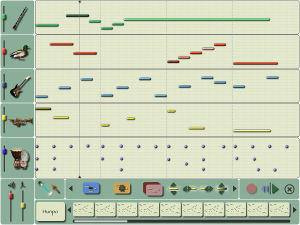TamTam
Other languages: Portuguese
A music and sound exploration application for the OLPC
TamTam is a suite of four music and sound related activities for the XO. TamTam is written in python with some C functions for speed-critical services. The audio engine for TamTam is Csound.
- miniTamTam
- is an introductory music activity aimed at younger children. One chooses amongst dozens of different sounds that can be played polyphonically on the XO keyboard. There is a small "beatbox" to generate rythms and a simple sequencer to record short snippets of keyboard playing.
- synthLab
- is an advanced application for older children who are ready to venture into sophisticated sound design. synthLab is a physics lab and sound synthesiser modelled on Max/MSP.
- TamTam Edit
- is a page driven event sequencer featuring a powerful music generator, a colorful and intuitive graphical interface to create, modify and organise notes on five virtual “tracks”, a palette of close to a hundred sounds and a music construction model that allows virtually limitless variations in all musical styles. TamTam Edit uses about 55-65% of the CPU when running full tilt and presently occupies about 30MB of ram.
- TamTam Jam
- The fourth component consisting of a collaborative playing and composing tool will be forthcoming as soon as the mesh network technology stabilizes.
Read the TamTam Release Notes for current release notes.
Goals
- Provide children with a culturally-informed environment for making music and sound on the OLPC;
- Provide an audio/music experience that is instantly rewarding for a musically naïve user;
- Provide a pathway to more sophisticated musical experiences;
- Provide a playable musical instrument with its own “sound”;
- Provide a dynamically adaptable learning environment that proposes simplicity and welcomes complexity;
- Use mesh networking to encourage collaborative music making;
- Introduce notions of audio and music programming.
People
- Jean Piché
- Olivier Bélanger
- James Bergstra
- Nathanaël Lécaudé
- Adrian Martin
- Eric Lamothe
TamTam is an educational application
Music is often described as the purest form of mathematical representation, driven instinctively by the human mind. It connects between people in many ways, and offers ways for expressing non-verbal emotion. In that sense music is related to problem-solving and communication.
On a more practical level, TamTam helps explore and explain ideas connected with sequences, fractions, repetition, transposition, and representation, all of which are helpful for an intuitive understanding of mathematics and many aspects of scientific enquiry. In the realm of applied physics, TamTam proposes tools to explore the phenomenon of sound and show how the manipulation of physical quantities have a direct effect on what is heard. A child's first physics lab starts with making sounds.
Sounds
This section provides information on the sound bank that will be used in TamTam. In addition to the sound bank, users will be able to record short samples using the internal microphone of the OLPC computer.
Release Notes
B2/Trial-1 Release Notes for TamTam activities
TamTam includes four activities: miniTamTam, TamTam Edit, TamTam Jam and synthLab. The third icon is not connected. This will be TamTam Jam in future releases.
- Microphone recording is not functional in all TamTam activities.
- in TamTam Edit
- The properties window lacks some graphics and is experimental. Most things work but may not yield expected results.
- The volumes silders for individual tracks sometimes stop responding. Starting/stopping or other manipulation will usually bring them back.
- The cntrl key is used to select / deselect pages for playback. This is somwhat unintuitive and will likely change. Triple-click on a page in the tuneview will select all pages.
- Keyboard recording is not implemented yet (thus the grayed-out red button).
- Sometimes, after manipulating notes on the screen, adding, erasing pages the "first note syndrome" will appear ie: the first notes of the page will fall silent. Rewinding to the beginning of the tune will usually fix the problem.
- General clues
- Do play around with the properties window. It allows to change individual sounds, full tracks or full pages.
- Do play with the Generation window. Its a little obscure presently but it can generate quite extraordinary music.
- Do try a lot of different instruments.
- Do experiment with synthLab. Its probably a little complicated for kids presently and needs to have complete sound design tutorials but an adult should be able to figure it out. The keyboard works the same way it does in miniTamTam.
- There is a quantizing sequence recorder in miniTamTam which works wonderfully. Left-click on the red record button will start recording on the next down beat and keep going until the drumloop has completed a full cycle. Right click allow you to record on top with another track. Note: the drum has to be playing for the sequencer to work.
Development
- How to use TamTam1
- High-level overview
- Source repository
- Tasks
- Interaction guideline
- File Format Discussion
IRC
We have a channel called #tam_tam on the Freenode network.
